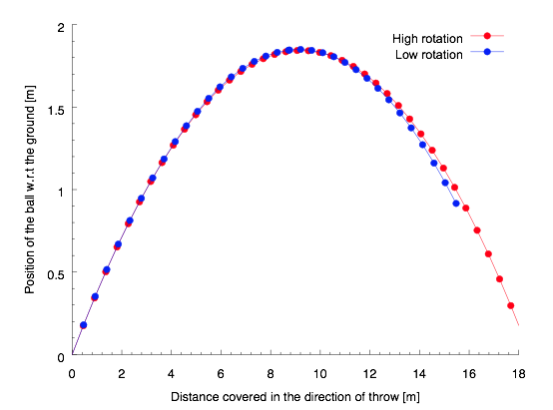 Every Sunday, Monday and Thursday millions of Americans tune in to watch their favorite players throwing the pigskin down the field. Tensions and emotions rise and fall with each play, game, and season. No doubt if you’re a Peyton Manning fan you have felt these ups and downs, along with a few “What kind of pass was that?” comments. Manning openly admits that his passes are sometimes a little “wobbly”, but he also “throws a lot of ‘wobbly’ touchdowns as well.”
Every Sunday, Monday and Thursday millions of Americans tune in to watch their favorite players throwing the pigskin down the field. Tensions and emotions rise and fall with each play, game, and season. No doubt if you’re a Peyton Manning fan you have felt these ups and downs, along with a few “What kind of pass was that?” comments. Manning openly admits that his passes are sometimes a little “wobbly”, but he also “throws a lot of ‘wobbly’ touchdowns as well.”
It begs the question, “What is the effect of a wobbly pass?” I mean, if Manning does it and is arguably one of the best quarterbacks in the NFL; what’s the big deal?
Convergent Science and Rescale teamed up to look at the science behind Manning’s pass using computational fluid dynamics (CFD) and cloud computing to study the effects of this “wobbly” pass.
The study was calculated using Convergent Science’s CONVERGE™ CFD solver. It contains an automated meshing process that simplifies the simulation set up. To run the analysis quickly and on hardware optimized for CFD simulations, Rescale offered up their on-demand high performance computing cloud simulation platform.
Simulation Overview (Warning: engineering content below)
When accurately simulating the flight of a football with CFD, we must make use of the Fluid Structure Interaction (FSI) capability within the CONVERGE software. Meaning we have to account for the aerodynamic drag on the wobbly pass and the spiraled pass to accurately determine the effects of the wobble on the distance and drop of the pass. The pressure forces acting on the football must be integrated to determine the direction of flight which makes the meshing the most important piece of the puzzle.
In this simulation, fixed embedding and Adaptive Mesh Refinement (AMR) are used. Fixed embedding retains sufficient grid resolution at the surface of the ball irrespective of its orientation and AMR is used to dynamically resolve the wake region based on the velocity field. In this particular simulation, the center of mass of the football is calculated based on the geometry. The ball is given an initial velocity and rotation; as expected the rotation rate plays an important role in determining the stability of the ball.

figure 1. compares of the flight of two footballs. The ball with a lower spin rate will “wobble” and has an unstable flight and covers a slightly shorter distance. - See more at: http://www.convergecfd.com/news-item/wobblypasscfd/#sthash.DHLgSLpW.dpuf
A pass rotating at a lower velocity will expectedly produce more of the trademark “wobble” we are looking to study. Spinning the pass at a higher velocity or rotational rate will produce the nice spiral that every quarterback tries to achieve.
Based on our analysis, we found that although we produced a pretty drastic “wobble” (figure 2) the effects were negligible. The distance shortened about 1 yard over 17 yards (15.5M) and dropped only slightly more than a spiral. Certainly, this can be the difference between an incomplete and complete pass with all things remaining constant. With today’s highly tuned athletes, this can be easily compensated for as Manning proves.
A pass rotating at a lower velocity will expectedly produce more of the trademark “wobble” we are looking to study. Spinning the pass at a higher velocity or rotational rate will produce the nice spiral that every quarterback tries to achieve.
Based on our analysis, we found that although we produced a pretty drastic “wobble” (figure 2) the effects were negligible. The distance shortened about 1 yard over 17 yards (15.5M) and dropped only slightly more than a spiral. Certainly, this can be the difference between an incomplete and complete pass with all things remaining constant. With today’s highly tuned athletes, this can be easily compensated for as Manning proves.

figure 2, top: Simulation in CONVERGE, football with “wobble.” figure 2, bottom: Simulation in CONVERGE, football spiraling. - See more at: http://www.convergecfd.com/news-item/wobblypasscfd/#sthash.DHLgSLpW.dpuf
Conclusion
While Manning might not have the prettiest pass in the NFL, he certainly has an effective one. With 24 touchdowns this season and only 5 interceptions, Peyton Manning is one of the top quarterbacks in the league. While we can study the physical effects of “wobble” on distance and ball drop, we cannot account for the human element and how quickly a top rated athlete will account for these physical phenomena.
If you are interested in running the case referenced above utilizing CONVERGE™ CFD software on Rescale, please contact us at [email protected] for details